CADILLAC SRX 2009 1.G Owners Manual
Manufacturer: CADILLAC, Model Year: 2009, Model line: SRX, Model: CADILLAC SRX 2009 1.GPages: 442, PDF Size: 2.42 MB
Page 291 of 442

Hood Release
To open the hood, do the following:
1. Pull the hood release
lever with this symbol
on it. It is located inside
the vehicle on the lower
left side of the
instrument panel.
2. Then go to the front of the vehicle and �nd the
secondary hood release lever. The lever is located
under the front edge of the grille near the center.
Move the release lever to the side and raise
the hood.
Before closing the hood, be sure all the �ller caps are
on properly. Then pull the hood down and close it �rmly.
5-11
Page 292 of 442
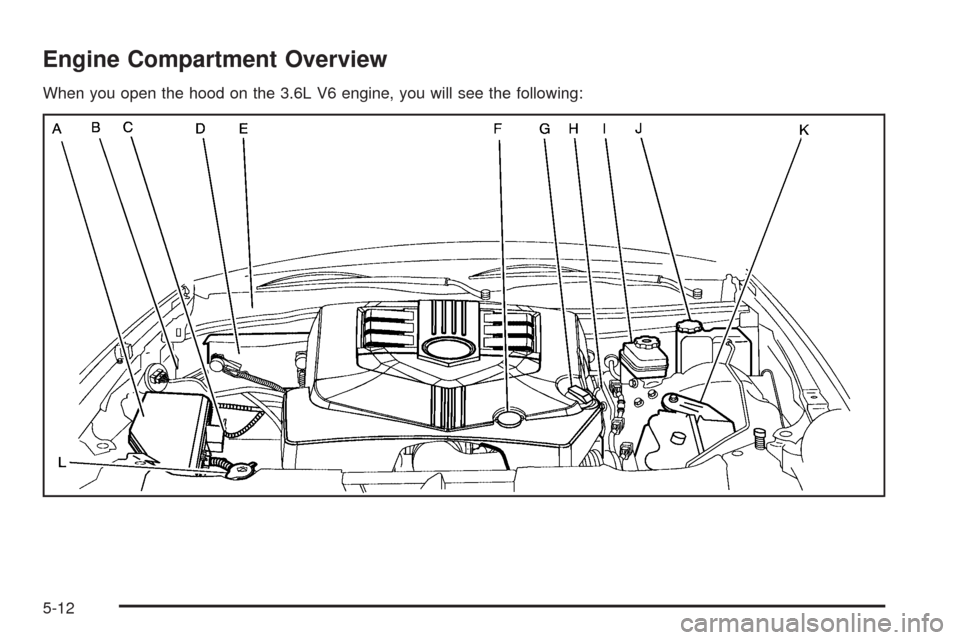
Engine Compartment Overview
When you open the hood on the 3.6L V6 engine, you will see the following:
5-12
Page 293 of 442
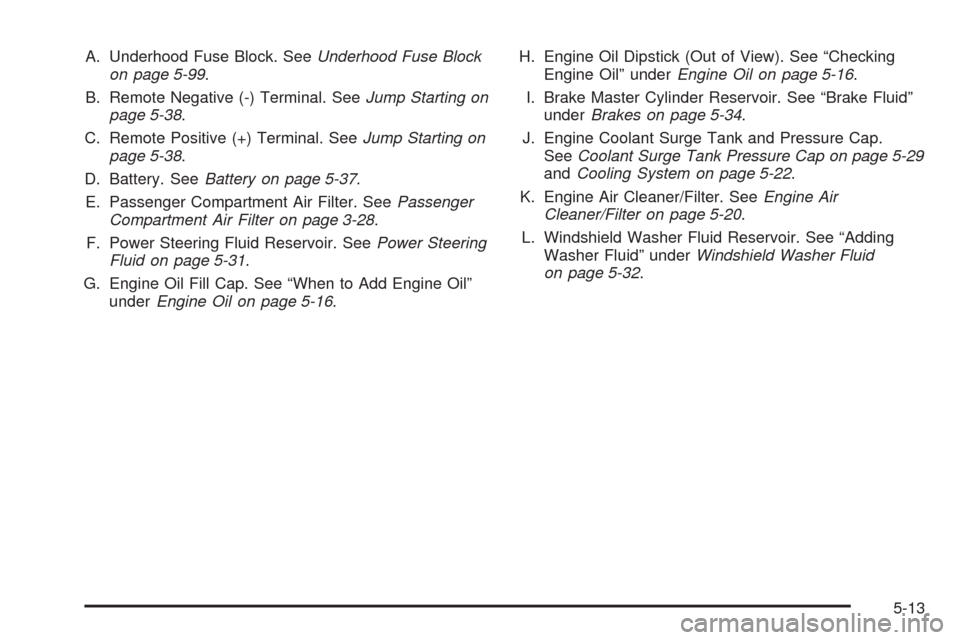
A. Underhood Fuse Block. SeeUnderhood Fuse Block
on page 5-99.
B. Remote Negative (-) Terminal. SeeJump Starting on
page 5-38.
C. Remote Positive (+) Terminal. SeeJump Starting on
page 5-38.
D. Battery. SeeBattery on page 5-37.
E. Passenger Compartment Air Filter. SeePassenger
Compartment Air Filter on page 3-28.
F. Power Steering Fluid Reservoir. SeePower Steering
Fluid on page 5-31.
G. Engine Oil Fill Cap. See “When to Add Engine Oil”
underEngine Oil on page 5-16.H. Engine Oil Dipstick (Out of View). See “Checking
Engine Oil” underEngine Oil on page 5-16.
I. Brake Master Cylinder Reservoir. See “Brake Fluid”
underBrakes on page 5-34.
J. Engine Coolant Surge Tank and Pressure Cap.
SeeCoolant Surge Tank Pressure Cap on page 5-29
andCooling System on page 5-22.
K. Engine Air Cleaner/Filter. SeeEngine Air
Cleaner/Filter on page 5-20.
L. Windshield Washer Fluid Reservoir. See “Adding
Washer Fluid” underWindshield Washer Fluid
on page 5-32.
5-13
Page 294 of 442
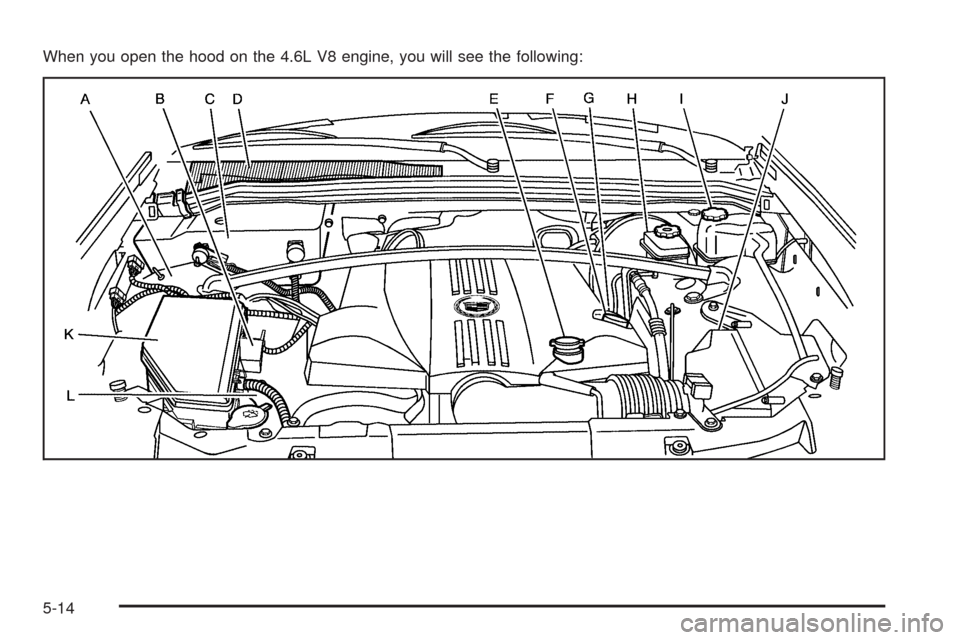
When you open the hood on the 4.6L V8 engine, you will see the following:
5-14
Page 295 of 442

A. Remote Negative (-) Terminal. SeeJump Starting on
page 5-38.
B. Remote Positive (+) Terminal. SeeJump Starting on
page 5-38.
C. Battery. SeeBattery on page 5-37.
D. Passenger Compartment Air Filter. SeePassenger
Compartment Air Filter on page 3-28.
E. Power Steering Fluid Reservoir. SeePower Steering
Fluid on page 5-31.
F. Engine Oil Fill Cap. See “When to Add Engine Oil”
underEngine Oil on page 5-16.
G. Engine Oil Dipstick (Out of View). See “Checking
Engine Oil” underEngine Oil on page 5-16.H. Brake Master Cylinder Reservoir. See “Brake Fluid”
underBrakes on page 5-34.
I. Engine Coolant Surge Tank and Pressure Cap.
SeeCoolant Surge Tank Pressure Cap on page 5-29
andCooling System on page 5-22.
J. Engine Air Cleaner/Filter. SeeEngine Air
Cleaner/Filter on page 5-20.
K. Underhood Fuse Block. SeeUnderhood Fuse Block
on page 5-99.
L. Windshield Washer Fluid Reservoir. See “Adding
Washer Fluid” underWindshield Washer Fluid
on page 5-32.
5-15
Page 296 of 442
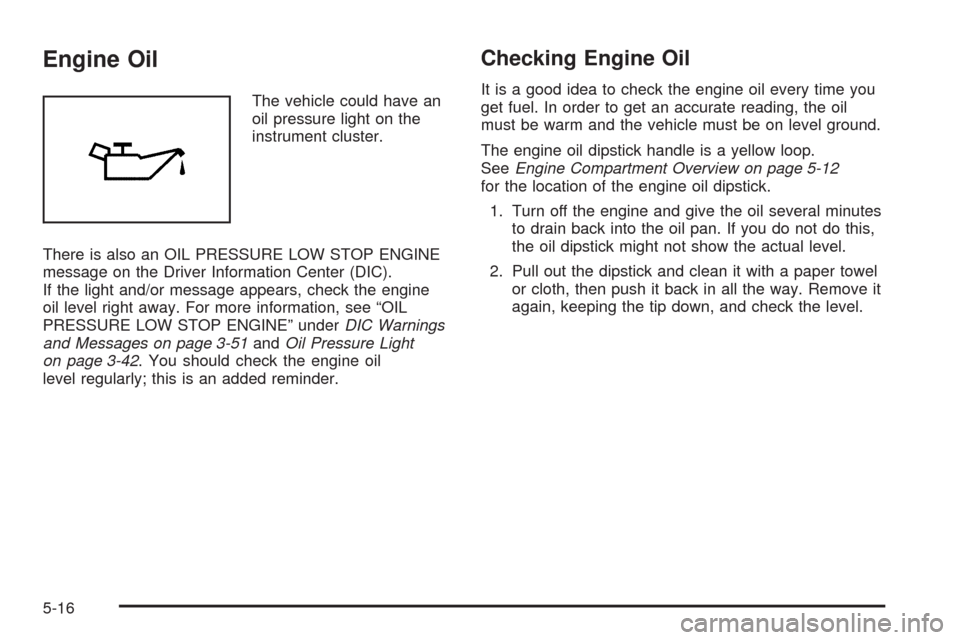
Engine Oil
The vehicle could have an
oil pressure light on the
instrument cluster.
There is also an OIL PRESSURE LOW STOP ENGINE
message on the Driver Information Center (DIC).
If the light and/or message appears, check the engine
oil level right away. For more information, see “OIL
PRESSURE LOW STOP ENGINE” underDIC Warnings
and Messages on page 3-51andOil Pressure Light
on page 3-42. You should check the engine oil
level regularly; this is an added reminder.
Checking Engine Oil
It is a good idea to check the engine oil every time you
get fuel. In order to get an accurate reading, the oil
must be warm and the vehicle must be on level ground.
The engine oil dipstick handle is a yellow loop.
SeeEngine Compartment Overview on page 5-12
for the location of the engine oil dipstick.
1. Turn off the engine and give the oil several minutes
to drain back into the oil pan. If you do not do this,
the oil dipstick might not show the actual level.
2. Pull out the dipstick and clean it with a paper towel
or cloth, then push it back in all the way. Remove it
again, keeping the tip down, and check the level.
5-16
Page 297 of 442
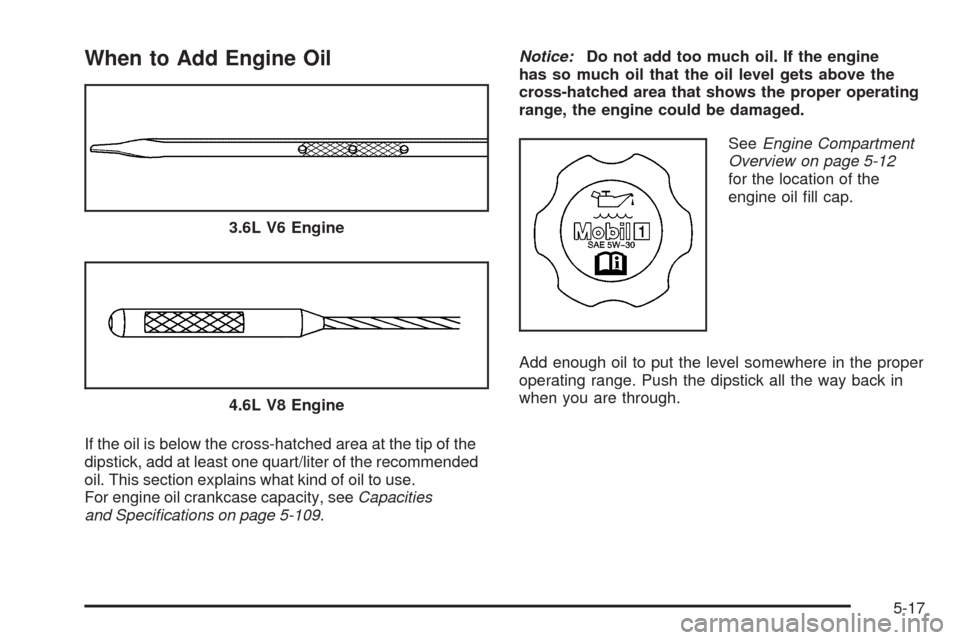
When to Add Engine Oil
If the oil is below the cross-hatched area at the tip of the
dipstick, add at least one quart/liter of the recommended
oil. This section explains what kind of oil to use.
For engine oil crankcase capacity, seeCapacities
and Specifications on page 5-109.Notice:Do not add too much oil. If the engine
has so much oil that the oil level gets above the
cross-hatched area that shows the proper operating
range, the engine could be damaged.
SeeEngine Compartment
Overview on page 5-12
for the location of the
engine oil �ll cap.
Add enough oil to put the level somewhere in the proper
operating range. Push the dipstick all the way back in
when you are through. 3.6L V6 Engine
4.6L V8 Engine
5-17
Page 298 of 442
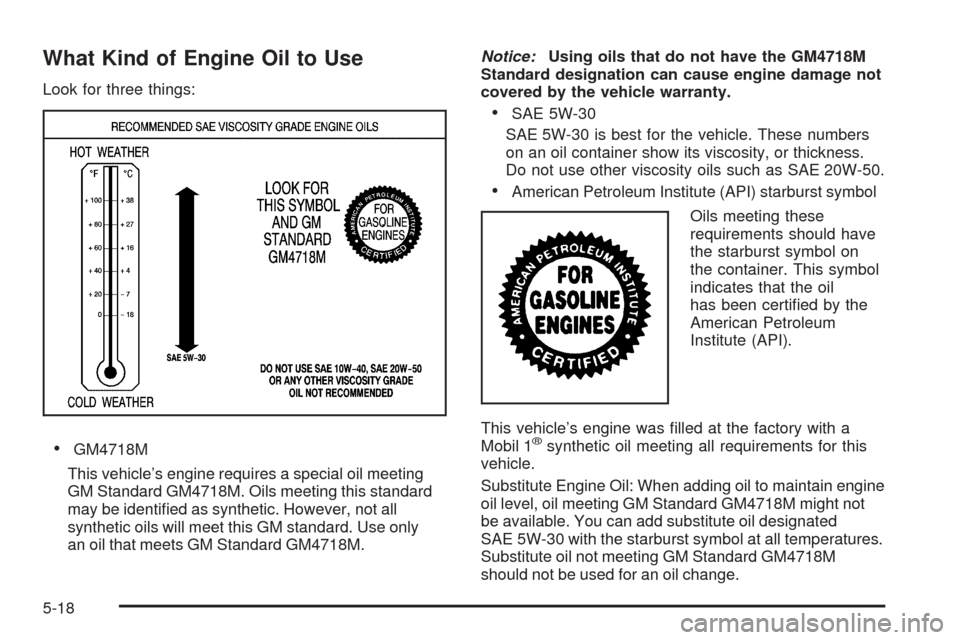
What Kind of Engine Oil to Use
Look for three things:
GM4718M
This vehicle’s engine requires a special oil meeting
GM Standard GM4718M. Oils meeting this standard
may be identi�ed as synthetic. However, not all
synthetic oils will meet this GM standard. Use only
an oil that meets GM Standard GM4718M.Notice:Using oils that do not have the GM4718M
Standard designation can cause engine damage not
covered by the vehicle warranty.
SAE 5W-30
SAE 5W-30 is best for the vehicle. These numbers
on an oil container show its viscosity, or thickness.
Do not use other viscosity oils such as SAE 20W-50.
American Petroleum Institute (API) starburst symbol
Oils meeting these
requirements should have
the starburst symbol on
the container. This symbol
indicates that the oil
has been certi�ed by the
American Petroleum
Institute (API).
This vehicle’s engine was �lled at the factory with a
Mobil 1
®synthetic oil meeting all requirements for this
vehicle.
Substitute Engine Oil: When adding oil to maintain engine
oil level, oil meeting GM Standard GM4718M might not
be available. You can add substitute oil designated
SAE 5W-30 with the starburst symbol at all temperatures.
Substitute oil not meeting GM Standard GM4718M
should not be used for an oil change.
5-18
Page 299 of 442
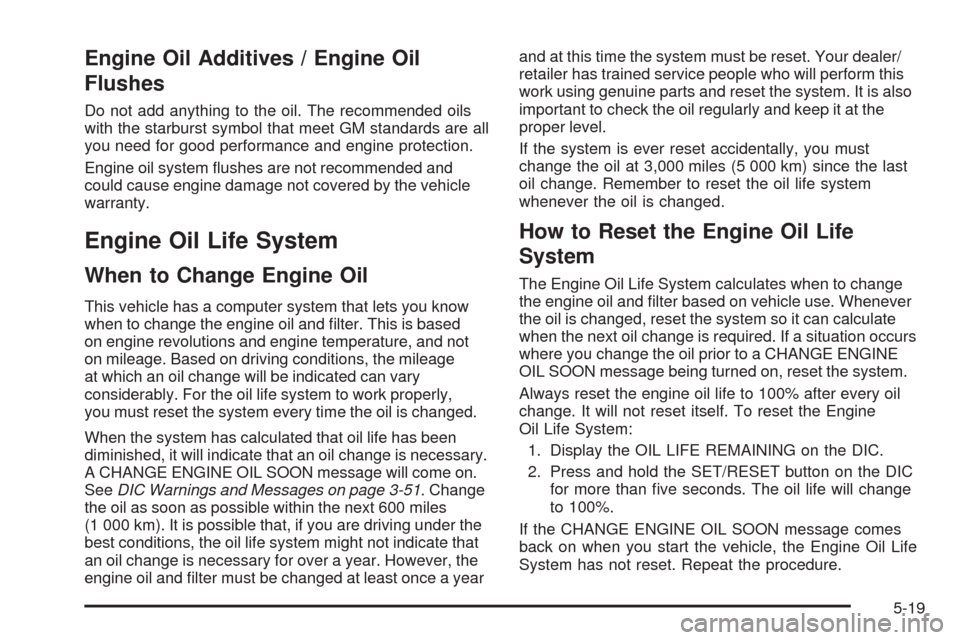
Engine Oil Additives / Engine Oil
Flushes
Do not add anything to the oil. The recommended oils
with the starburst symbol that meet GM standards are all
you need for good performance and engine protection.
Engine oil system �ushes are not recommended and
could cause engine damage not covered by the vehicle
warranty.
Engine Oil Life System
When to Change Engine Oil
This vehicle has a computer system that lets you know
when to change the engine oil and �lter. This is based
on engine revolutions and engine temperature, and not
on mileage. Based on driving conditions, the mileage
at which an oil change will be indicated can vary
considerably. For the oil life system to work properly,
you must reset the system every time the oil is changed.
When the system has calculated that oil life has been
diminished, it will indicate that an oil change is necessary.
A CHANGE ENGINE OIL SOON message will come on.
SeeDIC Warnings and Messages on page 3-51. Change
the oil as soon as possible within the next 600 miles
(1 000 km). It is possible that, if you are driving under the
best conditions, the oil life system might not indicate that
an oil change is necessary for over a year. However, the
engine oil and �lter must be changed at least once a yearand at this time the system must be reset. Your dealer/
retailer has trained service people who will perform this
work using genuine parts and reset the system. It is also
important to check the oil regularly and keep it at the
proper level.
If the system is ever reset accidentally, you must
change the oil at 3,000 miles (5 000 km) since the last
oil change. Remember to reset the oil life system
whenever the oil is changed.
How to Reset the Engine Oil Life
System
The Engine Oil Life System calculates when to change
the engine oil and �lter based on vehicle use. Whenever
the oil is changed, reset the system so it can calculate
when the next oil change is required. If a situation occurs
where you change the oil prior to a CHANGE ENGINE
OIL SOON message being turned on, reset the system.
Always reset the engine oil life to 100% after every oil
change. It will not reset itself. To reset the Engine
Oil Life System:
1. Display the OIL LIFE REMAINING on the DIC.
2. Press and hold the SET/RESET button on the DIC
for more than �ve seconds. The oil life will change
to 100%.
If the CHANGE ENGINE OIL SOON message comes
back on when you start the vehicle, the Engine Oil Life
System has not reset. Repeat the procedure.
5-19
Page 300 of 442
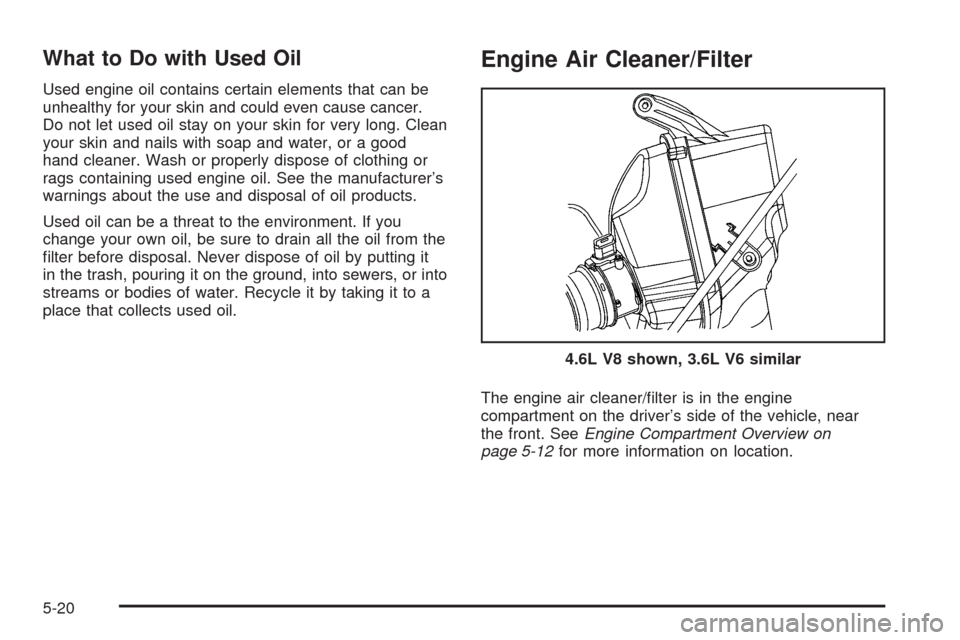
What to Do with Used Oil
Used engine oil contains certain elements that can be
unhealthy for your skin and could even cause cancer.
Do not let used oil stay on your skin for very long. Clean
your skin and nails with soap and water, or a good
hand cleaner. Wash or properly dispose of clothing or
rags containing used engine oil. See the manufacturer’s
warnings about the use and disposal of oil products.
Used oil can be a threat to the environment. If you
change your own oil, be sure to drain all the oil from the
�lter before disposal. Never dispose of oil by putting it
in the trash, pouring it on the ground, into sewers, or into
streams or bodies of water. Recycle it by taking it to a
place that collects used oil.
Engine Air Cleaner/Filter
The engine air cleaner/�lter is in the engine
compartment on the driver’s side of the vehicle, near
the front. SeeEngine Compartment Overview on
page 5-12for more information on location.4.6L V8 shown, 3.6L V6 similar
5-20